Corsair is a brand that is known for a lot of things, but their mice haven’t been part of many conversations in enthusiast circles so far. This Corsair Sabre Pro might well change that, however. This is a mouse that’s completely focused on esports players, and was designed along with a bunch of professional gamers. It has a flawless sensor, a light weight, a flexible cable, PTFE feet, and it’s capable of reaching a polling rate of 8000Hz, making it one of the first mice from the big brands to reach that milestone.
Impressive specs, no doubt, but we all know that specs don’t tell the whole story. For that reason we gave a unit to our reviewer so that he can tell you all about the Corsair Sabre Pro. Read our full review to find out his verdict!
At A Glance
Corsair Sabre Pro
Corsair have managed to make a very impressive mouse here. If you’re looking for a lightweight ergonomic mouse then this should definitely be one to consider, even if you don’t want to make use of its higher polling rates. An impressive release.
Pros
- Great gaming performance
- Nice clicks
- 8000Hz polling rate
- Good build quality
Cons
- Feet are subpar
- Thick cable
Specs
| Sensor | PMW 3392 |
|---|---|
| DPI | 100-18000, in steps of 1 |
| Polling Rate | 125 / 500 / 1000 / 2000 / 4000 / 8000 Hz |
| Button Switches | Omron |
| Connection | Wired |
| Shape | Ergonomic |
| Length | 12.23cm |
| Height | 4.20cm |
| Weight | 69g |
| Width | 6.23cm |
First Impressions
Corsair hasn’t always been hitting the mark with their mice. I’ve reviewed some of them but I can’t really say I’ve been thoroughly impressed by any of their mice, mostly because there’s always something about that them feels overly gimmicky or isn’t up to par, preventing me from truly recommending them. I can already say that the Sabre Pro is a different animal altogether. This mouse is aimed squarely at competitive esports players, and that shows.
The Sabre Pro doesn’t have any gimmicky additions or weird features; in fact it doesn’t even have RGB. There is an RGB version of this mouse for sale (called the Sabre RGB Pro) but I did not test that, so this review will be about the Sabre Pro.
What’s cool is that the designers at Corsair have really followed the ‘performance first’ credo. What you get is a large ultralight (we classify any mouse that weighs less than 70 grams as ultralight mouse) ergonomic mouse, which already makes it quite unique, but the fact that it achieves this without resorting to the ol’ honeycomb design deserves credit.
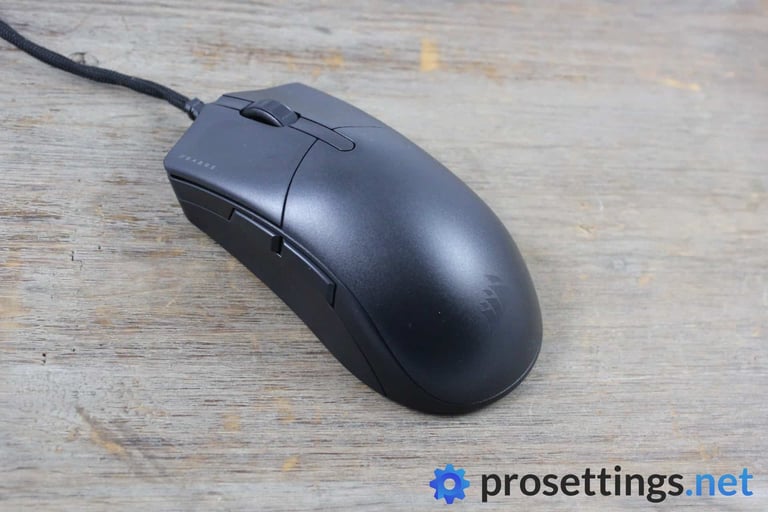
Even though the specs betray its true intentions, the exterior of this mouse is all business: even the Corsair logo is blacked out, and aside from a small and subtle ‘//SABRE’ on the left mouse button there is absolutely no branding on the mouse. I quite like the fact that Corsair has released an RGB-less mouse with a focus on performance that doesn’t compromise on anything, so I was pretty excited to try it out.
The Sabre Pro is a large ergonomic mouse with a familiar Intellimouse-based shape, though it’s not quite the same. It should sit well with a lot of people, and it’s nice to see a(nother) large ergo mouse with top tier specs being releases, seeing as ambidextrous mice have been dominating the market of competitive gaming mice.
I already sort of mentioned it, but what I love here is how simple it is. No extra buttons (aside from the DPI button on the bottom) and no flashy stuff: just a mouse that’s focused on performance.
Packaging
The packaging seems to follow the theme of the mouse: inside the box you get nothing but the mouse itself and some of the usual documentation. That’s fine by me, but with these esports-focused products I always like to see the inclusion of some extra mouse feet in the box, doubly so because there are cutouts near the feet to help you remove them, meaning that Corsair somewhat expects people to swap them out.
As always I won’t dock any points due to the lack of replacement feet, but it might be something they could think about for the future.
Shape, Coating, and Finish
What is ‘weird’ about the Sabre Pro is that it looks like an Intellimouse-based ergonomic mouse (think Razer DeathAdder and the likes for a more modern example) but it actually feels quite different in the hand than those mice. That’s due to the fact that the top half of the shell doesn’t have a lot of curvature at all: it’s mostly flat.
Towards the front it starts to slope a bit but it’s nowhere near what you usually see, which gives this mouse somewhat of a unique feeling when holding it, as if it’s some sort of a mixture between an ergonomic design and an ambidextrous design.
I quite like this shape, as I’ve come to dislike a strongly tilted mouse over the past couple of years, but if you’re coming from a very ‘formed’ ergonomic mouse you might need some time to adjust. That said: I don’t think that a lot of people who’ve come to enjoy these longer ergonomic shapes will have a lot of difficulties adjusting to this one, but it’s good to know that this mouse has little overall curvature (this also goes for the sides) when compared to more ‘traditional’ mice of this type overall.
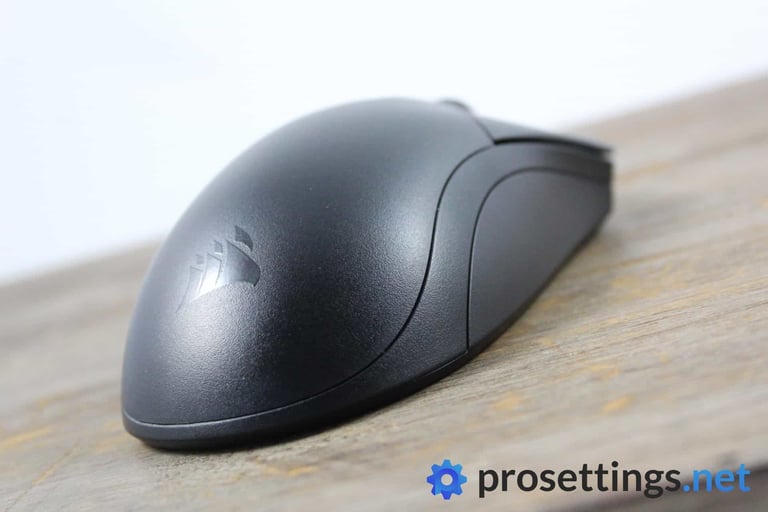
The coating on the mouse is very decent: it’s not the most amazing coating I’ve ever felt but for my moderately sweaty hands (at least while gaming) there were no performance issues, and it does a good job at handling skin oils and sweat. Small note: on the pictures it looks pretty glossy but in reality it doesn’t really have any of that typical gloss ‘stickiness’ so if you’re expecting that you may want to adjust your expectations.
On the bottom, then, we find four small feet. These are by far my least favorite aspect of the mouse, at least on my copy. They’re a bit scratchy for my liking and the overall glide just isn’t as smooth as I’d expect from a top tier gaming mouse these days. It’s not completely horrible: my gaming performance didn’t suffer or anything like that but this is definitely an aspect that could be improved upon.
Recommended Grip Types
The very nature of this mouse’s shape (a larger ergonomic mouse) means that it probably won’t be ideal for fingertip grippers, but I can see this as a great option for palm gripping, claw gripping, and anything in between. As long as you don’t mind the very limited tilt (when compared to some of the more popular large ergonomic mice) you should be good to go.
As always I want to place a disclaimer to end this section: everyone is different. You might have a fingertip grip and love large ergonomic mice, someone else might have the ‘perfect hand size’ for this mouse and hate it: the whole shape thing is subjective. As such you should take these grip recommendations that us reviewers give you with a grain of salt.
Buttons and Scroll Wheel
In their marketing, Corsair describes the Sabre Pro as having QUICKSTRIKE buttons but that is just a name for their special spring-loaded design to make the gap between the button and the switch nearly nonexistent. In reality, the Sabre Pro has regular Omron 50M switches. These are well known in enthusiasts circles, and while some manufacturers have been moving away from Omrons I have to say that I’ve never personally had any issues with them.
The clicks as a whole feel great: there is an audible difference between both main buttons, but aside from the fact that the left button feels just a tiny bit snappier (it’s barely noticeable though) they are uniform in their performance. There’s a small touch of post travel on both buttons, but it’s not enough to bother me, and the same goes for the minimal amount of side travel that’s found on the two main clicks. Overall one could say that these clicks are very nicely done, and I think these will satisfy most people, unless you really have something against Omron switches.
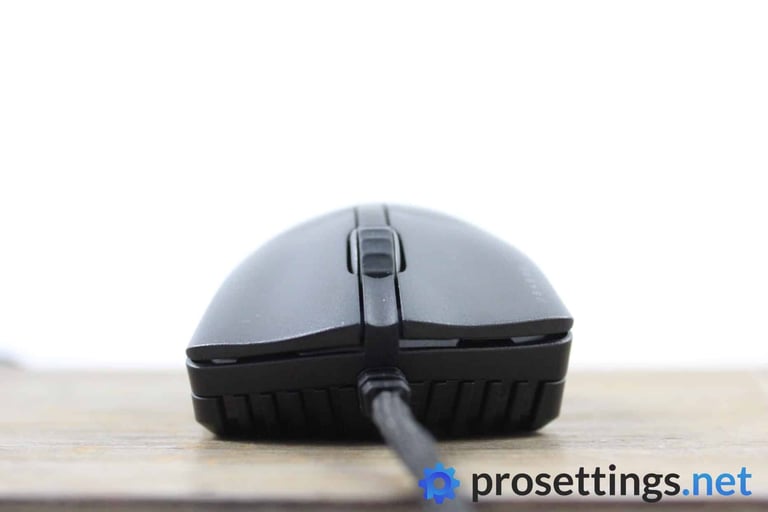
Thanks to Corsair’s ‘AXON Hyper-Processing Technology’ in combination with their QUICKSTRIKE system these should be among the snappiest clicks in the business. I don’t have any extremely reliable tests to get to the bottom of this claim, but I do know that I don’t really have any issues with the speed at which most gaming mice register their clicks so I don’t feel like this will be a net advantage for most people. That said: faster is always better, so I’m not saying that these technological advancements are useless; I’m just trying to frame how these things will feel for ‘the regular user.’
Will the clicks make you a better player? No, at least not if you’re coming from another respectable gaming mouse, but of course we never say no to improvements if they don’t hinder performance or raise the price too much so all is well on that front.
The side buttons are amazing. There’s a bit of ‘pivot’ on the front side button but leaving that aside these are pretty much perfect in my opinion. They are snappy, there’s minimal travel, and they actuate with a satisfying and crispy clicking action.
If I’m being nitpicky I would say that the scroll wheel could use a bit more tactility (though that’s just my subjective opinion) but overall it’s a great wheel. It doesn’t mess up and it does its job without being extremely loud or rigid.
Build Quality and Cable
When you shake the Sabre Pro up and down you’ll hear and feel the scroll wheel moving around. For me that’s not a real issue, as you never use a mouse vertically in game anyway (except for when you pick it up to reset after a swipe, but the noise wasn’t present during those moves) and luckily it stays silent otherwise.
Aside from this minor mishap I couldn’t find any issues with the build quality. The mouse passed all the regular ‘squeeze tests’ (including the one where you try to activate a side button by pressing hard on the side of the shell) with flying colors, so as far as I’m concerned this is a solidly built mouse.
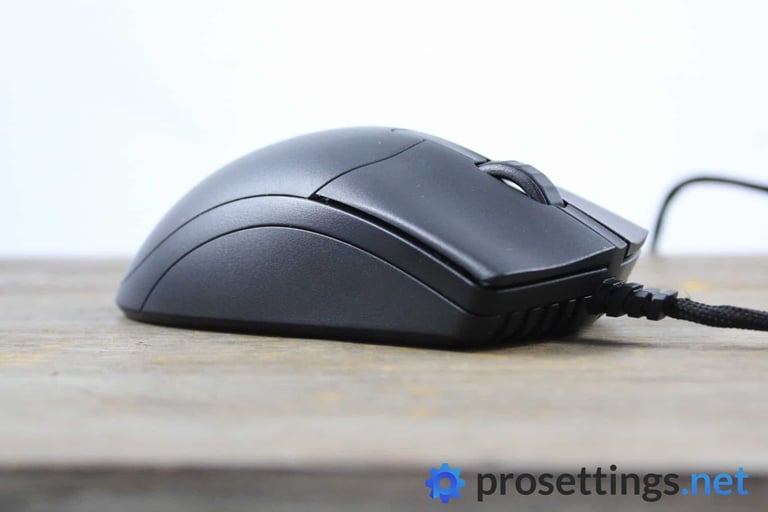
As we saw with the Razer Viper 8KHz, a mouse with a polling rate of 8000 Hz needs to have a firmer cable because of the fact that this kind of technology requires extra shielding. As such, this doesn’t have the most flexible cable I’ve ever tested, but it will certainly do fine for most people. I used the Sabre Pro with and without a mouse bungee for my testing and I didn’t really have any issues in any scenario, though I would recommend a bungee if you’re planning on using this mouse as your daily driver; it’s always nice to have a bit of that wireless feeling.
As I’m not sure what the effect of a paracord on this kind of performance would be I wouldn’t really recommend switching out the cable for now, so it’s good that this one is very usable.
Sensor and Everyday Performance
Powering the Sabre Pro is the 3392 sensor. That’s not a common one, but it is completely flawless. During my testing I found no evidence of smoothing, snapping, or any of those shenanigans so the Sabre Pro behaves exactly like a top tier gaming mouse should.
The kicker is of course that 8000Hz polling rate. I will start off with a disclaimer: using a mouse with a polling rate that high (the Sabre Pro sits at 1000 Hz by default) will require a beefy system with a powerful CPU. Corsair says the following on their website: “a minimum of an Intel® i7 9th generation or AMD Ryzen™ 7 2nd generation processor (or equivalent) is required for the best 8,000Hz hyper-polling experience.” Aside from that you’ll also need a high refresh rate monitor in order to get the best out of this technology, otherwise the increase in polling rate just won’t be noticeable.
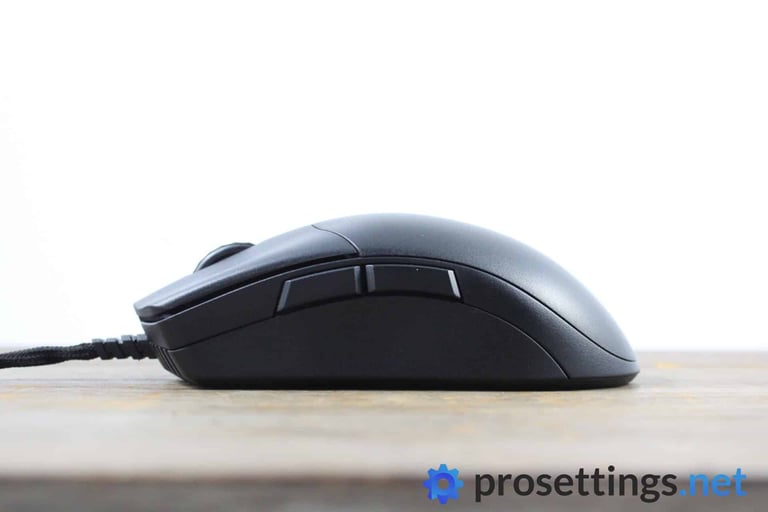
With that out of the way we get to the important question: is 8000Hz worth it? I already answered this in my review of the Viper 8Khz, but since the tech is new I’ll also answer that question here. In short: it is noticeable, but the performance increase is so marginal that it should absolutely not be a defining factor when purchasing a mouse. I mostly feel an improvement in situations where I had to track smaller objects and make micro adjustments, but it’s not as if using the 8000 Hz polling rate suddenly made me way better at those tasks. If anything it can make you slightly more consistent. Aiming is (and always will be) mostly done by the person using the mouse. Unless you’re cheating, but that’s a different discussion.
To summarize: if this mouse sounds like it ticks all the right boxes for you (and it definitely could, as it has some very interesting specs) then by all means try out the 8000Hz polling rate, if your system can handle it. If you have a feeling that you won’t like the shape or something like that you absolutely shouldn’t buy this mouse over others just because it’s capable of that higher polling rate, though. There are far more important factors to consider when buying a mouse than polling rate.
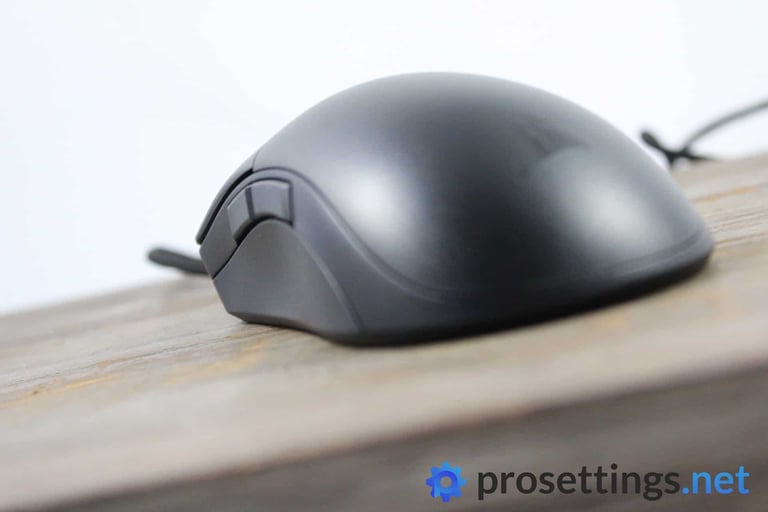
As with all Corsair products you can tweak the settings of this one in Corsair’s iCUE software. This has seen a little bit of a revamp, but it’s still not the most user friendly program out there. You will have to install if if you plan on using this mouse with its 8000 Hz polling rate though, so bear that in mind.
As a short closing statement on this segment I’d like to say that the 8000Hz technology is definitely impressive, and I am not against it. It’s not the selling point of this mouse (not in their marketing and not in general if you ask me) so it’s not as if Corsair has put all of their eggs in one basket: this is a nicely specced gaming mouse that performs well on all levels. The fact that it can go up to 8000 Hz is just the cherry on top of the sundae. If you like the flavors of said sundae then by all means go for the Sabre Pro, but if you’re only buying it for the cherry you’ll be disappointed if you don’t like the rest.
Corsair Sabre Pro Review – Conclusion
To be completely honest I don’t really expect a whole lot from Corsair mice due to my past experiences with them, but the company has really managed to surprise me with this release.
The Corsair Sabre Pro is a reliable large ergonomic ultralight mouse with an interesting shape. Inside of it you’ll find a flawless sensor, great clicks, a nice scroll wheel, and the ability to use a polling rate of 8000 Hz. All of this can be found in a reliable package that doesn’t have to make any compromises as far as the build quality goes to reach its weight of 69 grams. The only aspects that do not live up to expectations are the feet and the cable, but that last one can be excused as a more rigid cable is required if you want to include the option to use a polling rate of 8000Hz.
For my full opinion on the 8000Hz polling rate you should read the ‘performance and sensor’ section (I say this because I know some people skip to the conclusion) but in short: consider it to be a nice little extra. If you like everything about the mouse then it’s nice to be able to use it at those higher polling rates, but you should not go out and buy this if you do not like the other aspects of the mouse just to get your hands on a mouse with a polling rate of 8000 Hz.
But the Sabre Pro RGB doesn’t need that 8000 Hz polling rate to be exciting. Even leaving aside that technology for a moment, Corsair have managed to make a very impressive mouse here. If you’re looking for a lightweight ergonomic mouse then this should definitely be one to consider, even if you don’t want to make use of its higher polling rates. An impressive release.
This product was received for free from the manufacturer and given to our reviewer to test and review. Brands and manufacturers have no editorial control over our reviews. For more information, check out our review FAQ.


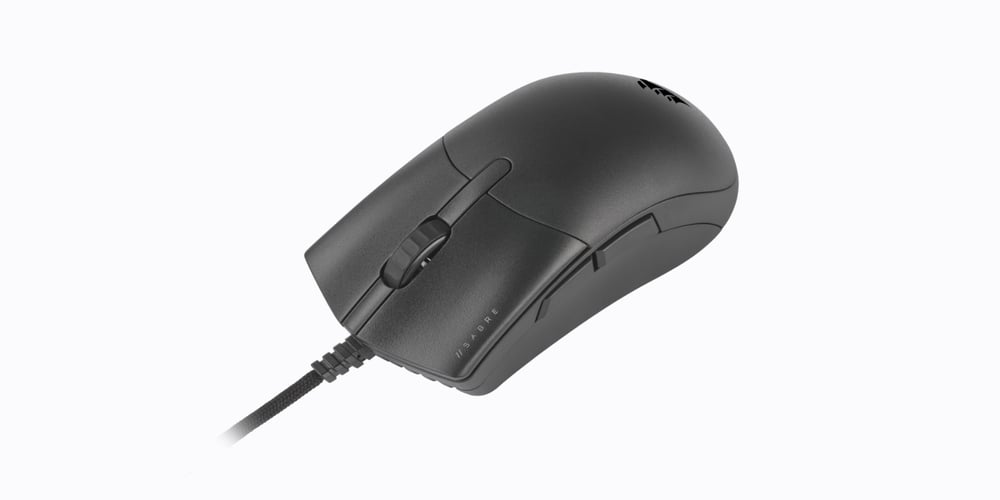

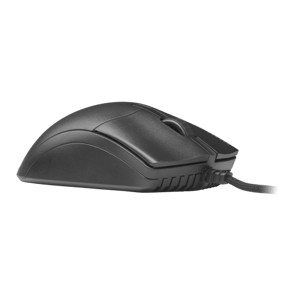


What mouse would you recommend for fingertip with a medium / small hand? I prioritize precision and speed as I play a lot of FPS I have tried superlight/G-pro probably my favorite 2 so far but am looking to get something a little smaller.
If you’re looking for something smaller you could look at the Razer Viper Mini, or something like the Glorious Model O- (Wireless). One of my favorite mice right now is the Xtrfy M42 Wireless, that could also work for fingertip grip. There’s also the recently released Razer Viper V2 Pro but I feel that might be a bit too long for fingertip grip.